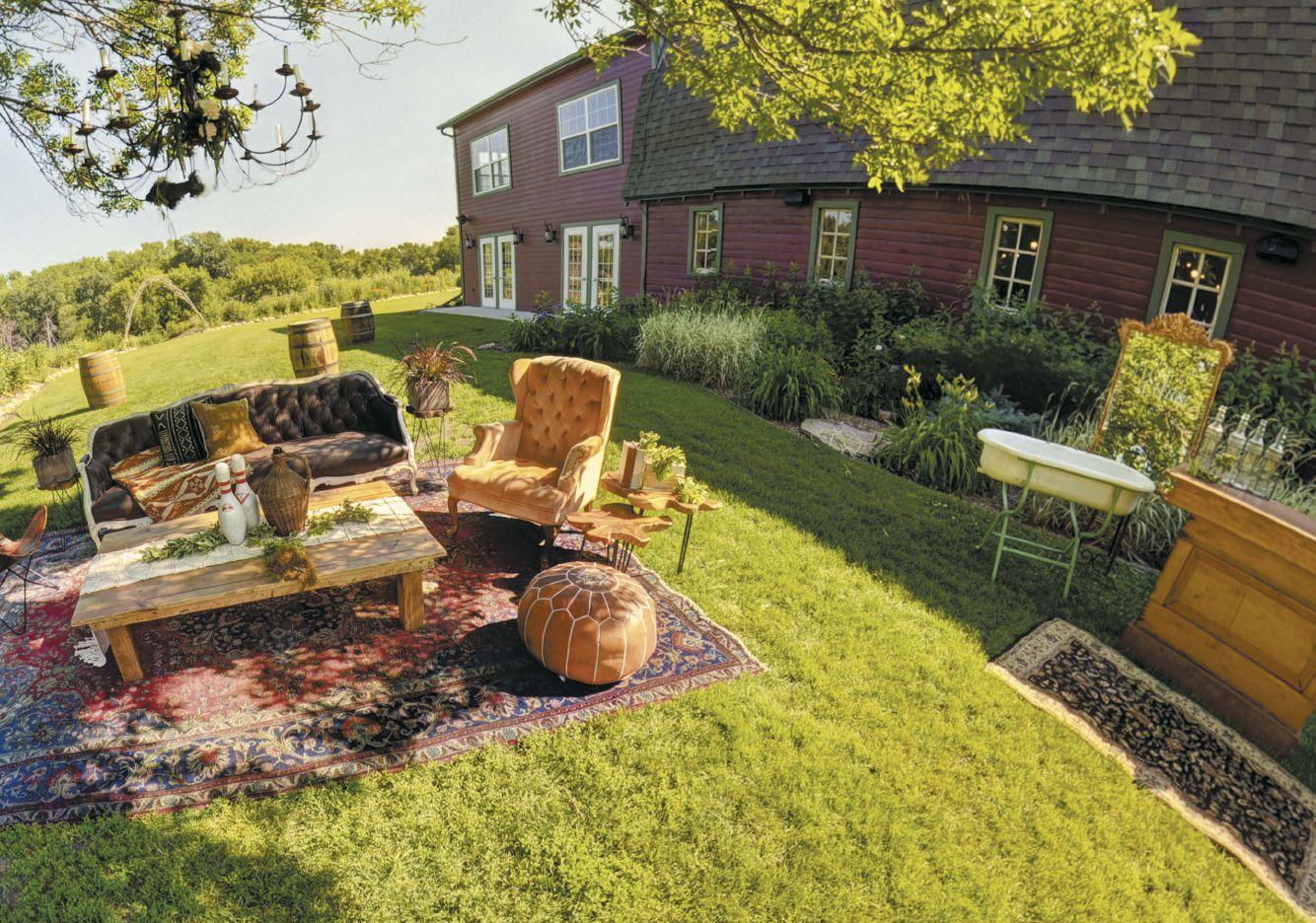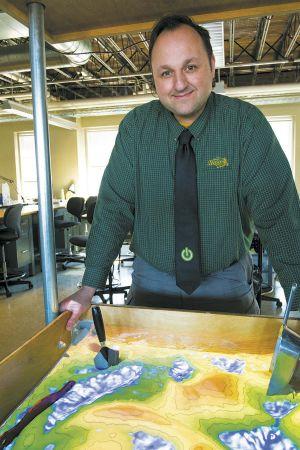
4 minute read
Executives are learning what gamers have long known: VR is like nothing else on Earth
By Tom Dennis
With its sloping, windowless walls, reinforced concrete construction and 79-foot height, the Missile Site Control Building at the Stanley R. Mickelsen Safeguard Complex looms over the landscape like a 4,000-yearold Egyptian pyramid.
So it’s ironic that the structure near Nekoma, N.D., is now being marketed using the most modern of tools: virtual reality.
Ironic – and effective. “The population of Nekoma is 49, and since the virtual tour of the Mickelsen complex went live in the fall, we’ve had 108,000 hits,” said Shannon Duerr, executive director of the Cavalier County (N.D.) Job Development Authority.
The authority acquired the former antiballistic missile site in October, and now is trying to attract government agencies, data centers and anyone else who could put the highly secure facility to good use.
The virtual-and-VR tour at the authority’s website, ccjda.org, is the result.
“The hits have come from all 50 states and 95 different countries,” Duerr said.
“It’s such an immersive experience compared to just looking at pictures. I don’t know what else we could have done that would have gotten 108,000 sets of eyes on our site.”
The marketing of the Mickelsen complex is a regional sign of a global phenomenon: the growing use of virtual reality for commercial, nonprofit and educational purposes.
That growth promises to be explosive. “The global virtual reality market was valued at approximately $2.02 billion in 2016 and is expected to reach approximately $26.89 billion by 2022,” Zion Market Research of New York reported in February.
Not only are the costs of Oculus Rift and other headsets with their own screens coming down, but also, Google Cardboard and similar viewers can turn smartphones into VR devices for about $7.
The latter is what puts the VR element in the Mickelsen complex tour.
“There are two ways you can visit the facility on our website,” Duerr said.
The first is to just click on the link. That takes visitors to a two-dimensional but 360-degree virtual tour, similar to the ones colleges now offer to prospective students.
The second is to use VR glasses or a headset that you can attach to your phone.
“You click on the screen to switch to VR, the display gets split into two, and you’re there,” Duerr said.
“We keep a couple of headsets in the office so that when people visit, they can try it. They reach their hands out when they have the headset on, they try to walk around. It’s fun to watch.”
The authority developed the tour with the help of Be More Colorful, a Fargo company that specializes in creating such experiences.
“We are an interactive media agency,” said Matthew Chaussee, CEO.
“That means we create 360-degree imagery and virtual-reality content to help businesses promote their physical spaces.”
The work is exciting because it’s so clearly the wave of the future, Chaussee said.
“We’ve done event venues, dental offices, a pumpkin patch, the Medora Musical and Pitchfork Steak Fondue,” he said.
Basically, any group that wants people to visit a place can use VR to offer a 3D online tour.
Plus, the VR user not only is “in” the space, but also can interact with it. “This is a choose-your-own-adventure type of thing,” Chaussee said.
“And every time you come back to it, you experience it a little differently. So it really engages the viewer in a way that traditional photos and video do not.”
Rustic Oaks, a wedding and special-event venue on a farmstead outside of Moorhead, Minn., is another Be More Colorful customer.

“A huge majority of our weddings happen from May through October,” said Emily Finley, sales director.
“But a lot of engagements seem to happen from Thanksgiving to Valentine’s Day – the wintry months. So, we wanted a way to let potential customers tour the venue without having to drive out here, as well as to show them what it looks like like during the summertime.”
The venue’s website – RusticOaks.net – now features a virtual tour that can, with a click, turn into a virtual-reality tour.
“This way, people can visit from a coffee shop or work, plus they can step into our spaces and walk through our inns and barn,” Finley said.
“It’s a great tool that I’m sure more and more venues will get into.”
One distinction that’s worth noting is between virtual reality – which puts you in a different “place” than you are in your physical reality –and augmented reality, which takes something real and adds digital elements to it.
Think fighter pilots using a “heads up” display: that’s augmented reality, said Ben Bernard, computer service specialist in the architecture and landscape architecture department at North Dakota State University.
So is the augmented reality sandbox, a unique tool used at NDSU, the University of North Dakota and elsewhere.


The sandbox is just that: a sandbox, but with an augmented-reality projector installed overhead. The machine projects topographic lines, digital rivers and lakes, map colors and other features onto the sandscape, then adjusts instantly as students scoop and pile sand.
“We can even replace the water with lava if we want to,” Bernard said.
“This is just really fun technology. And when students reach in and start sculpting, they get a much better idea of how things like landscaping, topographic lines and water flow work.”
Architects such as those trained at NDSU were among virtual reality’s first adopters, as Eric Johnson, director of visualization at JLG Architects in Grand Forks, can attest.
“Truly, VR is changing the way architects design buildings right now,” Johnson said.
“And it will do so even more in the future.”
These days, architects routinely work in 3D on a project from start to finish. “And that’s both internally and externally, when we show clients design options and explore spatial relationships,” he said.
Clients often will put on an Oculus Rift or other PC-connected headset to step inside the design.
“The sensation of actually being in the space – I think that’s the biggest thing,” Johnson said.
“It gives you that immersive feeling, and that special relationship is very hard to match with 2D plans, including renderings and animations.”
Next up: Untethered VR, with a PCequipped headset that won’t have to be connected to a computer; and room-scale VR, where headset wearers will move physically – not just virtually – through space.
“The whole field of architecture is changing faster than I’ve ever seen it,” Johnson said.
“And this is just the tip of the iceberg now.”
Tom Dennis Editor, Prairie Business
701-780-1276 tdennis@prairiebusinessmagazine.com
ABOVE: BEN BERNARD, COMPUTER SERVICE SPECIALIST AT NORTH DAKOTA STATE UNIVERSITY, STANDS BY THE AUGMENTED-REALITY SANDBOX USED BY LANDSCAPE ARCHITECTURE STUDENTS. THE DEVICE USES CUSTOM SOFTWARE TO PROJECT TOPOGRAPHIC LINES AND OTHER MAP FEATURES ONTO THE SAND. IMAGE: NICK NELSON/FORUM NEWS SERVICE

TOPOGRAPHIC LINES AND OTHER MAP FEATURES CAN BE SEEN HERE AS THEY LOOK IN NORTH DAKOTA STATE UNIVERSITY'S AUGMENTED REALITY SANDBOX. IMAGE: NDSU











